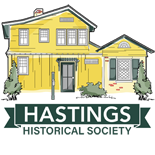 For our very first post on this blog, we thought we’d take you back 180 years to 1879, the year when Hastings-on-Hudson was officially recognized by New York State as a “village.” The map you see here is one of the treasures of our collection. It is the survey that was drawn up George Wiley of Tarrytown as part of Hastings’ application for incorporation.
For our very first post on this blog, we thought we’d take you back 180 years to 1879, the year when Hastings-on-Hudson was officially recognized by New York State as a “village.” The map you see here is one of the treasures of our collection. It is the survey that was drawn up George Wiley of Tarrytown as part of Hastings’ application for incorporation.
The map shows far more than just the boundaries of the proposed village. Look closely at the detail below, and you will see a little blue vertical line in the center — the stream running through the Ravine to the river. (Does something seem to be missing? Warburton Avenue bridge was not built until 1898.) To the left of the stream is the railroad “depot”, and next to that is a “Main Street” (now the beginning of Southside Avenue). The street we now call Main Street is on the map, but without any label. Washington Avenue, however, is clearly marked. At the top right of the map is a blue band representing the Croton Aqueduct, and right below that is a building labeled “school” – that is the Fraser Free School, one of the earliest public schools in Hastings and now the Hook & Ladder firehouse at 50 Main Street. The word “Mills” to the left of the school refers not to a mill, but to Edmund S. Mills, the owner of property on both sides of what we now call Main Street. There are more familiar names on the map, too, like Draper, Chrystie, Leffurgy, and Minturn. The tiny print on the left-hand side, about half way down, reads “old Hickory,” which may be one of the trees that the surveyor used as a guide. It is possible that the large red dots in the downtown area served a similar purpose. If you can help us out on this one, let us know!
Our map did not always look this good. By 1982 it had started to crack. Pieces had come loose and some were already missing. We sent it to the Northeast Document Conservation Center in Massachusetts, a regional center that specializes in paper conservation, for their opinion. They recommended treatment to remove the dirt and to replace the old cloth backing with a new backing of mulberry paper, to which the loose pieces could be attached with wheat starch.
The treatment was expensive, but a long-time friend of the Society, Joel Dean, came to the rescue. Now encased in archival polyester, this piece of Hastings history resides in the map case in our upper archive room, which also houses 400 more maps, plans, and surveys of Hastings.














Greetings all. This is a great idea and well done. I look forward to more.
I have been scanning a number of my father’s old negatives and will send copies to you of Hastings images.
Thanks for all of your work to preserve Hastings history.
Bill Ewen
Thanks Bill! We aim to please. And looking forward to photos!
Fatima, you have done an awesome job in starting this blog! Here’s hoping it reaches many present and former Hastingsites.
Barbara McManus
What a gift to the community this will be. Well done, Fatima and the HHS trustees!
Diggitt McLaughlin
ALERT! Diggit just pointed out to me that 2009 minus 1879 is 130 years and not 180 years. Sorry, folks!
It would've been more fun if you also posted a modern map of the exact same place for comparison's sake. That way, we would be able to see what was added and removed in Hastings-on-Hudson more clearly. But I must commend you for doing such a great job in restoring the old map, Fatima! That's an important relic for the field of surveying. I wonder which tools they used to make that.
Yes, I wonder, Jesse. Must have been a tough job in the 19th century. But funny thing is that not many maps of the entire village are made anymore, and they never include buildings. Too bad!
Wow! Talk about an old map. Land surveying really did come from a long way. I wonder how did they manage to finish mapping the place? It must have really taken a lot of time. It's amazing how you were able to restore this old map, it must be hard and yet fun, right?